
"The volume could easily be doubled ... what is in these pages is but a considered sample of the realm of traditional music. Perhaps it can be expanded for future editions."
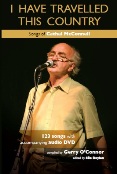 Cathal McConnell
is a third generation flute player from Co. Fermanagh in Northern Ireland.
In the late 1960s he co-founded the Boys of the Lough
[32],
which became one of the most successful Celtic bands after
Scottish fiddler Aly Bain [37]
and Northumbrian mandolinist Dave Richardson (who wrote a foreword here) joined the line-up.
Cathal's virtuosity on the flute easily conceals
that he's a fine traditional singer with a large repertoire of songs he collected since the 1960s
(partially with Len Graham who wrote another foreword).
Many of these songs have never been recorded and were
at risk of being lost. Thus fiddler Gerry O'Connor
[46],
who knows Cathal since his late teens when travelling to Fermanagh
and ending up in the McConnell household, started recording him and ended up with 123 songs
from Cathal's native Fermanagh and the neighbouring counties. It is a treasure trove,
from the comical song "The Amadán" to the 1798 rebel song "The Wind That Shakes the Barley,"
of which Cathal recorded three different melodies on the 6 hours DVD Rom.
There are familiar ditties such as the "Curragh of Kildare"
(recorded by the Boys of the Lough on their "Lonesome Blues & Dancing Shoes"
album [23]),
and English versions of popular Gaelic songs such as
"Airdí Cuain" and "Donal Og." The title song I Have Travelled This Country
I heard only recently for the first time recorded
by the Mancunian House Devils,
who incidentally also did the "Hare's Lament" [47].
Many more I've never encountered before, including
songs penned by Cathal's dad Sandy McConnell.
The book has the words, plus additional verses Cathal don't sing,
and brief commentary on his sources - but no musical notation.
Cathal McConnell
is a third generation flute player from Co. Fermanagh in Northern Ireland.
In the late 1960s he co-founded the Boys of the Lough
[32],
which became one of the most successful Celtic bands after
Scottish fiddler Aly Bain [37]
and Northumbrian mandolinist Dave Richardson (who wrote a foreword here) joined the line-up.
Cathal's virtuosity on the flute easily conceals
that he's a fine traditional singer with a large repertoire of songs he collected since the 1960s
(partially with Len Graham who wrote another foreword).
Many of these songs have never been recorded and were
at risk of being lost. Thus fiddler Gerry O'Connor
[46],
who knows Cathal since his late teens when travelling to Fermanagh
and ending up in the McConnell household, started recording him and ended up with 123 songs
from Cathal's native Fermanagh and the neighbouring counties. It is a treasure trove,
from the comical song "The Amadán" to the 1798 rebel song "The Wind That Shakes the Barley,"
of which Cathal recorded three different melodies on the 6 hours DVD Rom.
There are familiar ditties such as the "Curragh of Kildare"
(recorded by the Boys of the Lough on their "Lonesome Blues & Dancing Shoes"
album [23]),
and English versions of popular Gaelic songs such as
"Airdí Cuain" and "Donal Og." The title song I Have Travelled This Country
I heard only recently for the first time recorded
by the Mancunian House Devils,
who incidentally also did the "Hare's Lament" [47].
Many more I've never encountered before, including
songs penned by Cathal's dad Sandy McConnell.
The book has the words, plus additional verses Cathal don't sing,
and brief commentary on his sources - but no musical notation.
Gerry O'Connor (ed), I Have Travelled This Country - Songs of Cathal McConnell.
Lughnasa Music, 2011, ISBN 978-0-9511569-3-3, pp172, €25,00 (incl. DVD Rom).
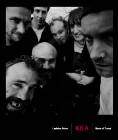 Irish fusion group Kíla once started out as an ordinary trad band.
One day Rónán [30] announced:
Right lads. That's it. I'm not gonna play me bodhrán along to any more
tunes that youse haven't written yourselves.
The rest is history, as they say [44].
Kíla's Book of Tunes features over 100 jigs and reels, polkas and waltzes, but not exactly traditional...
With their complex arrangements they are rather musical tales,
stripped down here they have to stand all on their own. Will any tune make it
into the prevalent Irish session repertoire? Perhaps!
The tunes are listed in chronological order, kicking off with
Colm's [35]
4-part jig "The Physiotherapist",
which they played on a Slogadh competition and were sacked for because it wasn't trad enough,
plus tunes from Eoin's first solo album
[32]
and Dee's forthcoming solo album. They are written out both in staff notation and ABCs
(why publish a book we can't read? asked Rossa and Rónán),
and accompanied by photographs from the band's history as well as
poetic and prosaic pieces from fellow artists such as fiddlers
John Sheahan [39]
and Colm Mac Con Iomaire [38].
There is also Rossa's Journal of Music article "Spuds and Tunes,"
where he compared traditional tunes with potatoes. Kíla's dish then is:
Trad Hotpot - New potatoes, sweet potatoes, exotic and indigenous vegetables, lamb,
goat or yak, red wine, beef stock, sugar, flour and herbs from the world market
as opposed to Pure Boiled Trad or Bunratty Boxty Trad.
(Funny and worth reading even if you can't play a single note.)
The book also features a brief explanation of Steve Cooney's solar notation system,
a geometric visualisation of music, demonstrated with Eoin's "Liffey Reel."
So altogether it is much much more than a tunebook, but a proud artistic statement
and a band's declaration of policies.
Irish fusion group Kíla once started out as an ordinary trad band.
One day Rónán [30] announced:
Right lads. That's it. I'm not gonna play me bodhrán along to any more
tunes that youse haven't written yourselves.
The rest is history, as they say [44].
Kíla's Book of Tunes features over 100 jigs and reels, polkas and waltzes, but not exactly traditional...
With their complex arrangements they are rather musical tales,
stripped down here they have to stand all on their own. Will any tune make it
into the prevalent Irish session repertoire? Perhaps!
The tunes are listed in chronological order, kicking off with
Colm's [35]
4-part jig "The Physiotherapist",
which they played on a Slogadh competition and were sacked for because it wasn't trad enough,
plus tunes from Eoin's first solo album
[32]
and Dee's forthcoming solo album. They are written out both in staff notation and ABCs
(why publish a book we can't read? asked Rossa and Rónán),
and accompanied by photographs from the band's history as well as
poetic and prosaic pieces from fellow artists such as fiddlers
John Sheahan [39]
and Colm Mac Con Iomaire [38].
There is also Rossa's Journal of Music article "Spuds and Tunes,"
where he compared traditional tunes with potatoes. Kíla's dish then is:
Trad Hotpot - New potatoes, sweet potatoes, exotic and indigenous vegetables, lamb,
goat or yak, red wine, beef stock, sugar, flour and herbs from the world market
as opposed to Pure Boiled Trad or Bunratty Boxty Trad.
(Funny and worth reading even if you can't play a single note.)
The book also features a brief explanation of Steve Cooney's solar notation system,
a geometric visualisation of music, demonstrated with Eoin's "Liffey Reel."
So altogether it is much much more than a tunebook, but a proud artistic statement
and a band's declaration of policies.
Kíla, Leabar Foinn - Book of Tunes.
Coiscéim/Kíla Records,
2011, ISBN 978-0-9567859-0-9, pp200, €30.
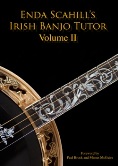 Irish banjo ace Enda Scahill has been performing for more than a decade with
melodeonist Paul Brock
[34][45].
In his previous banjo tutorial [38]
he established the bedrock to build upon, the Irish Banjo Tutor Volume II
completes the higher levels. On the first floor, Enda discusses reducing tension and to train to
become a relaxed player with body posture, breathing and mind set.
These pages are vital for the next steps, introducing ornamentation such as trebles,
triplets, slides, hammer-ons and pull-offs, and create the nyah, i.e.
Irish music's swing and phrasing.
Throughout the tutorial he uses two rather unfamiliar tunes to demonstrate
a smorgasbord of tips, techniques, approaches and concepts,
the "New Post Office Reel" (which fiddler Martin Hayes recorded
[35])
and the "Champion Jig." For starters he demonstrates them straightforward, then adding
his suggestions one after another.
More tunes are introduced (both stave notes and tab), and Enda indicates variation,
alternate tuning (he himself is using ADAE ever since instead of the fiddle tuning GDAE
which Barney McKenna [41]
introduced in the 1960s), harmony notes and chords -
all meant to develop an individual style and make any tune your very own.
Eventually, there is a chapter on old-time music and how
to play the American 5-string- on the Irish 4-string-banjo.
Every banjoist will find something, ambitious novices as well as advanced players.
The two accompanying CDs are featuring tunes and techniques played both slowly and at regular pace.
Irish banjo ace Enda Scahill has been performing for more than a decade with
melodeonist Paul Brock
[34][45].
In his previous banjo tutorial [38]
he established the bedrock to build upon, the Irish Banjo Tutor Volume II
completes the higher levels. On the first floor, Enda discusses reducing tension and to train to
become a relaxed player with body posture, breathing and mind set.
These pages are vital for the next steps, introducing ornamentation such as trebles,
triplets, slides, hammer-ons and pull-offs, and create the nyah, i.e.
Irish music's swing and phrasing.
Throughout the tutorial he uses two rather unfamiliar tunes to demonstrate
a smorgasbord of tips, techniques, approaches and concepts,
the "New Post Office Reel" (which fiddler Martin Hayes recorded
[35])
and the "Champion Jig." For starters he demonstrates them straightforward, then adding
his suggestions one after another.
More tunes are introduced (both stave notes and tab), and Enda indicates variation,
alternate tuning (he himself is using ADAE ever since instead of the fiddle tuning GDAE
which Barney McKenna [41]
introduced in the 1960s), harmony notes and chords -
all meant to develop an individual style and make any tune your very own.
Eventually, there is a chapter on old-time music and how
to play the American 5-string- on the Irish 4-string-banjo.
Every banjoist will find something, ambitious novices as well as advanced players.
The two accompanying CDs are featuring tunes and techniques played both slowly and at regular pace.
Enda Scahill's Irish Banjo Tutor Volume II.
2012, ISBN 978-0-957-14100, pp80, €25
(www.endascahill.com).
 I've heard there was a secret chord that David played, and it pleased the Lord ...
Leonard Cohen's [46] classic song
could serve as a motto for the two volumes of Great Songs For Guitar - Chord Songbook.
There's not a single note, but lyrics only with guitar chord boxes but time signature as well.
It takes getting used to it. The Black and White Book, respectively,
contain seventeen hits from older and more recent times,
from hard rockers AC/DC ("Highway To Hell")
to new wave band The Police ("Every Breath You Take") and
jazz pianist Fats Waller ("Ain't Misbehavin'").
Folkies may indulge in Willie Nelson's "Crazy",
Don MacLean's "American Pie", Bob Dylan's "Don't Think Twice",
Johnny Cash's "I Walk The Line" and Gordon Lightfoot's "If You Could Read My Mind"
(most of these in the black volume).
Well, three cords and a hallelujah then!!!
I've heard there was a secret chord that David played, and it pleased the Lord ...
Leonard Cohen's [46] classic song
could serve as a motto for the two volumes of Great Songs For Guitar - Chord Songbook.
There's not a single note, but lyrics only with guitar chord boxes but time signature as well.
It takes getting used to it. The Black and White Book, respectively,
contain seventeen hits from older and more recent times,
from hard rockers AC/DC ("Highway To Hell")
to new wave band The Police ("Every Breath You Take") and
jazz pianist Fats Waller ("Ain't Misbehavin'").
Folkies may indulge in Willie Nelson's "Crazy",
Don MacLean's "American Pie", Bob Dylan's "Don't Think Twice",
Johnny Cash's "I Walk The Line" and Gordon Lightfoot's "If You Could Read My Mind"
(most of these in the black volume).
Well, three cords and a hallelujah then!!!
Adrian Hopkins (ed.), Great Songs for Guitar - Chord Songbook - The White Book.
Wise Publications AM1004091,
2011, ISBN 978-1-78038-374-3, pp48, €15,95.
Adrian Hopkins (ed.), Great Songs for Guitar - Chord Songbook - The Black Book.
Wise Publications AM1004102,
2011, ISBN 978-1-78038-375-0, pp48, €15,95.
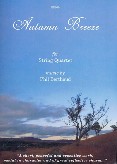 The Derbyshire based violinist, mandolinist and guitarist Phil Berthoud,
who also published two-volume tutorials for fiddle and mandolin
("Around the World in 80 Tunes"
[45]),
presents an original mini suite for two violins, viola and violoncello, Autumn Breeze.
Crisp and spot on, relaxing and at rest. I see a landscape before my eyes -
though I'm not sure if it's the green hills of Devonshire (Berthoud's residence)
or the dusty savannah of Zimbabwe (his birthplace).
The Derbyshire based violinist, mandolinist and guitarist Phil Berthoud,
who also published two-volume tutorials for fiddle and mandolin
("Around the World in 80 Tunes"
[45]),
presents an original mini suite for two violins, viola and violoncello, Autumn Breeze.
Crisp and spot on, relaxing and at rest. I see a landscape before my eyes -
though I'm not sure if it's the green hills of Devonshire (Berthoud's residence)
or the dusty savannah of Zimbabwe (his birthplace).
Phil Berthoud, Autumn Breeze for String Quartet.
Spartan Press SP860,
2011, ISMN 979-0-57999-860-0, pp3, €4,99.
 In the last FW issue I reviewed button accordionist Paddy O'Brien's latest CD,
featuring his wife Erin Hart singing a couple of
songs [46].
During the winter I eventually managed it to read the first of Erin's mystery novels,
Haunted Ground, taking place in East Galway, an area fairly saturated with flute players,
and you never knew when a bit of music might turn up.
The plot is about archeologist Cormac Maguire and pathologist Nora Gavin trying to establish
the identity of a 17th century bog woman,
at the same time becoming curious about the disappearance and apparent murder of a local woman
and her child. The entire book is resounding with traditional Irish music,
the garda detective playing the fiddle, Cormac is a flutist, and
Nora turns out to be a singer with a dark, earthy voice.
Eventually she remembers a traditional Irish song that unravels the mystery.
Already in the credits Erin acknowledges her friend Dáithí Sproule
[46]
(only a couple of days before reading I'd seen him backing up Altan
[47]),
she furthermore thanks musicians such as
Sean O'Driscoll [29],
James Kelly [31],
Susan McKeown [44]
and Niamh Parsons [34].
If you're a crime fiction fan only, you might better stay with Bruen, McGilloway, Kerrigan or Bateman.
If you're a music fan only, take a listen to Paddy O'Brien's d’oeuvre.
If you're fond of both, you're served well with Erin Hart's novels.
In the last FW issue I reviewed button accordionist Paddy O'Brien's latest CD,
featuring his wife Erin Hart singing a couple of
songs [46].
During the winter I eventually managed it to read the first of Erin's mystery novels,
Haunted Ground, taking place in East Galway, an area fairly saturated with flute players,
and you never knew when a bit of music might turn up.
The plot is about archeologist Cormac Maguire and pathologist Nora Gavin trying to establish
the identity of a 17th century bog woman,
at the same time becoming curious about the disappearance and apparent murder of a local woman
and her child. The entire book is resounding with traditional Irish music,
the garda detective playing the fiddle, Cormac is a flutist, and
Nora turns out to be a singer with a dark, earthy voice.
Eventually she remembers a traditional Irish song that unravels the mystery.
Already in the credits Erin acknowledges her friend Dáithí Sproule
[46]
(only a couple of days before reading I'd seen him backing up Altan
[47]),
she furthermore thanks musicians such as
Sean O'Driscoll [29],
James Kelly [31],
Susan McKeown [44]
and Niamh Parsons [34].
If you're a crime fiction fan only, you might better stay with Bruen, McGilloway, Kerrigan or Bateman.
If you're a music fan only, take a listen to Paddy O'Brien's d’oeuvre.
If you're fond of both, you're served well with Erin Hart's novels.
Erin Hart, Haunted Ground. 2003.
Last but not least, Oslo's Musikk Husets Forlag has published a couple of tutorials and sheet music
with traditional Norwegian music as well as east European gypsy and folk music.
www.musikk-huset.no
That was the word in the first edition of the Companion to Irish Traditional Music way back in 1999.[27] Its editor Fintan Vallely, a flutist and also author of "Tuned Out"[38] and "Sing Up",[39] has been busy and eventually presents a revised and expanded second edition.
832 instead of 478 pages, 214 instead of 108 contributors, about 1,800 instead of 500 articles, and unfortunatly 59 instead of 25 € as well.
This A-Z encyclopedia is a reference guide to traditional Irish music and culture. A score of specialists from all conceivable aspects inform about traditional Irish music, song and dance, history, people and instruments.
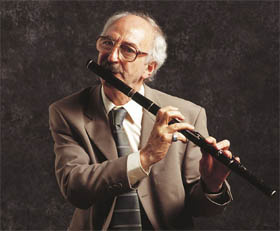
Cathal McConnell @ FolkWorld: FW#23, #32, #38 www.myspace.com | www.youtube.com www.cathalmcconnell.com www.boysofthelough.com |
From a capella to Zozimus, from the Loughnashade trumpet[31] to Riverdance and hip-nós. Besides historical personalities such as Thomas Moore[37] or Seán Ó Riada,[28] an overview is given on artists and bands from trad band Altan[47] to a capella group Whisht!.[38]
|
|
I will not and cannot give an account on anything in detail. Of course, there is an entry about the Boys of the Lough flutist and singer Cathal McConnell, who published a fine song book recently (see box on the right), and another about this songbook's editor Gerry 'Fiddle' O'Connor. Banjo player Enda Scahill is featured, and so is accordionist Paddy O'Brien, while the crossover band Kíla is mentioned in the article bands under the sub category fusion.
|
|
There are articles on flute, fiddle, accordion and banjo - and other instruments as well. Anything related to or important for Irish music is covered, e.g. the Scottish label Greentrax Recordings[46] or English Topic Records.[40] Everyone of the 36 Irish counties has an entry, and every European country in which Irish music has a cultural presence, i.e. Denmark, Finland, France, Italy, Norway - and Germany.

Paddy O'Brien @ FolkWorld: FW#33, #35, #46 myspace.com | youtube.com www.paddyobrien.net www.chulrua.com |
For sure, I'm not very impartial since having written the Companion entry on Irish music in Germany, based on an older article published here on the FolkWorld website.[34] So let's finish this review with my contribution as just one example and to give you an idea what the Companion is all about.
Last but not least, there is an index to locate hundreds of people and bands, plus a timeline and a bibliography (a discography is omitted). A supporting website, www.companion.ie, provides web links to all featured items, and there are plans of a digitised app and an e-book version.
Ulrike Dangendorf, Brombeerschnee. Westpark Music 89063, 2011, ISBN 978-3-937942-16-5, pp64, €21,95.
Photo Credits:
(1ff) Book Covers,
Cathal McConnell,
Gerry O'Connor,
Enda Scahill,
Paddy O'Brien,
Kíla
(from website/author/publishers).